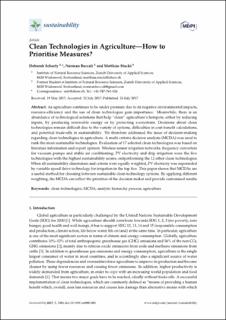Please use this identifier to cite or link to this item:
https://doi.org/10.21256/zhaw-4832| Publication type: | Article in scientific journal |
| Type of review: | Peer review (publication) |
| Title: | Clean technologies in agriculture : how to prioritise measures? |
| Authors: | Scharfy, Deborah Boccali, Norman Stucki, Matthias |
| DOI: | 10.21256/zhaw-4832 10.3390/su9081303 |
| Published in: | Sustainability |
| Volume(Issue): | 9 |
| Issue: | 8 |
| Issue Date: | 2017 |
| Publisher / Ed. Institution: | MDPI |
| ISSN: | 2071-1050 |
| Language: | English |
| Subjects: | Agriculture; LCA; Solar; Cleantech |
| Subject (DDC): | 338.927: Environmental economics and sustainable development 630: Agriculture |
| Abstract: | As agriculture continues to be under pressure due to its negative environmental impacts, resource-efficiency and the use of clean technologies gain importance. Meanwhile, there is an abundance of technological solutions that help “clean” agriculture’s hotspots, either by reducing inputs, by producing renewable energy or by protecting ecosystems. Decisions about clean technologies remain difficult due to the variety of options, difficulties in cost-benefit calculations, and potential trade-offs in sustainability. We therefore addressed the issue of decision-making regarding clean technologies in agriculture. A multi-criteria decision analysis (MCDA) was used to rank the most sustainable technologies. Evaluation of 17 selected clean technologies was based on literature information and expert opinion. Wireless sensor irrigation networks, frequency converters for vacuum pumps and stable air conditioning, PV electricity and drip irrigation were the five technologies with the highest sustainability scores, outperforming the 12 other clean technologies. When all sustainability dimensions and criteria were equally weighted, PV electricity was superseded by variable speed drive technology for irrigation in the top five. This paper shows that MCDAs are a useful method for choosing between sustainable clean technology options. By applying different weighting, the MCDA can reflect the priorities of the decision maker and provide customised results. |
| URI: | https://digitalcollection.zhaw.ch/handle/11475/11715 |
| Fulltext version: | Published version |
| License (according to publishing contract): | CC BY 4.0: Attribution 4.0 International |
| Departement: | Life Sciences and Facility Management |
| Organisational Unit: | Institute of Natural Resource Sciences (IUNR) |
| Published as part of the ZHAW project: | Applying Life Cycle Assessment for the mitigation of environmental impacts South African agrifood products |
| Appears in collections: | Publikationen Life Sciences und Facility Management |
Files in This Item:
| File | Description | Size | Format | |
|---|---|---|---|---|
| 2017_Scharfy_Clean_technologies_in_agriculture.pdf | 2.27 MB | Adobe PDF |  View/Open |
Show full item record
Scharfy, D., Boccali, N., & Stucki, M. (2017). Clean technologies in agriculture : how to prioritise measures? Sustainability, 9(8). https://doi.org/10.21256/zhaw-4832
Scharfy, D., Boccali, N. and Stucki, M. (2017) ‘Clean technologies in agriculture : how to prioritise measures?’, Sustainability, 9(8). Available at: https://doi.org/10.21256/zhaw-4832.
D. Scharfy, N. Boccali, and M. Stucki, “Clean technologies in agriculture : how to prioritise measures?,” Sustainability, vol. 9, no. 8, 2017, doi: 10.21256/zhaw-4832.
SCHARFY, Deborah, Norman BOCCALI und Matthias STUCKI, 2017. Clean technologies in agriculture : how to prioritise measures? Sustainability. 2017. Bd. 9, Nr. 8. DOI 10.21256/zhaw-4832
Scharfy, Deborah, Norman Boccali, and Matthias Stucki. 2017. “Clean Technologies in Agriculture : How to Prioritise Measures?” Sustainability 9 (8). https://doi.org/10.21256/zhaw-4832.
Scharfy, Deborah, et al. “Clean Technologies in Agriculture : How to Prioritise Measures?” Sustainability, vol. 9, no. 8, 2017, https://doi.org/10.21256/zhaw-4832.
Items in DSpace are protected by copyright, with all rights reserved, unless otherwise indicated.